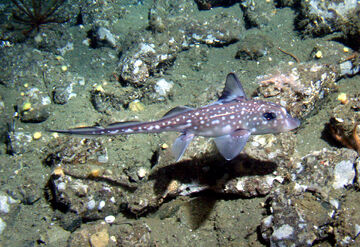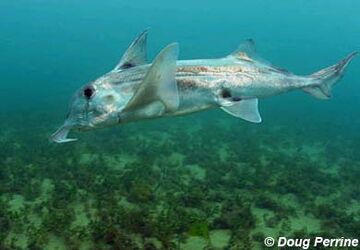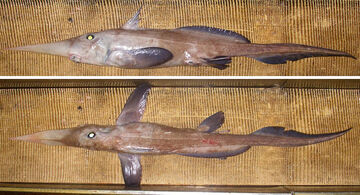Defining Features
Sometimes referred to as “ghostfish” or “ratfish”, Chimaeriformes are identified by a fleshy operculum that covers a single gill opening. They have a grinding tooth plate and an immobile upper jaw that is fused to the skull. They have seperate anal and urogential openings and lack a stomach. Males possess a retractable clasper on the head and paired claspers on the pelvic fins. They are oviparous. Most species have a large head and a whip-like tail.
Habitat and Range
Chimaeras are deep sea fishes. They are demersal species typically located near ocean floors nearing 200-2,600 m in depth; although, a few species are found in waters shallower than 200 m. Two families are found in temperate and tropical oceans worldwide, although members of the Callorhinchidae family are ounly found in the Southern Hemisphere.
Fisheries Conservation and Concern
The status of many species is unknown because they live in deep waters. Most are not target species, but some are occasionally caught as bycatch in deep sea fisheries. The lack of data regarding longevity, age at maturity, growth, reproductive rates, and population structures means that some species may be subject to overharvesting.
Closest Relatives
Elasmobranchii OR Batoidea + [Squaloidea+Galoidea]
Example Species in Chimaeriformes

Ref: wikipedia.org/wiki/Spotted_ratfish
Spotted Ratfish
Hydrolagus colliei
Defining Features: The spotted ratfish can reach up to 97 cm in total length, including its long tail. It has iridescent brown or gray skin with white spots. There is a venomous spine anterior to the first dorsal fin.
Range & Habitat: The spotted ratfish is located in the Northeast Pacific Ocean from Baja California to Alaska. It is marine oceanic and neritic occurring at depths of 0 - 913 m.
IUCN Concern: This is a species of least concern, but it is a source of bycatch in some deep sea fishing operations.

Ref: https://www.floridamuseum.ufl.edu/discover-fish/species-profiles/callorhinchus-milii/
Elephantfish
Callorhinchus milii
Defining Features: The elephantfish possesses a long, flexible, fleshy snout that is used to probe the seafloor for prey. The remaining body is somewhat flattened. It is black or brown in color.
Range & Habitat: The elephantfish is located in the Pacific Ocean surrounding Australia and New Zealand. It is a marine neritic species occurring inshore at depths < 200m.
IUCN Concern: This is a species of least concern. In Australia it is often caught as bycatch, but in New Zealand there is an apparently stable, target fishery.
Example Species in the Gulf of Maine

Ref: https://www.fishbase.se/photos/PicturesSummary.php?StartRow=0&ID=9005&what=species&TotRec=3
Atlantic Longnoes Chimaera
Rhinochimaera atlantica
Defining Features: The Atlantic longnose chimaera can reach up to 140 cm in total length. It possesses a long, flattened, narrow snout. It is whitish to light brown in color.
Range & Habitat: The Atlantic longnose chimaera is marine oceanic and is widely distributed on the Atlantic’s continental slopes at depths of 500 to 1500 m.
IUCN Concern: The Atlantic longnose chimaera is listed as a species of least concern. It is occasionally caught as bycatch in deepwater trawls, but there is no data to indicate population impacts. Specimens are primarily recovered in research trawls.
References
Chondrichthyan Tree of Life: sharksrays.org
Florida Museum of Natural History: floridamuseum.ufl.edu
IUCN Redlist: iucnredlist.org
Fish Base: fishbase.org
Aquamaps: aquamaps.org